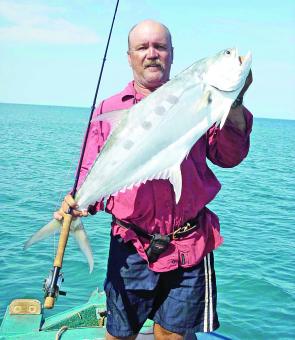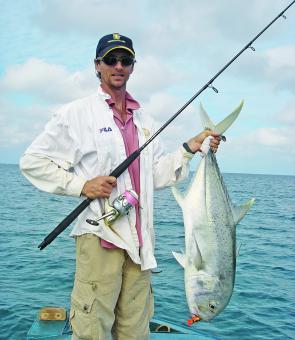May is when the transition from our long tropical summer to our balmy northern winter takes place. The fishing options over the next several weeks will be dictated by the strength and pattern of the winter trade winds.
Fortunately even if the strong southeasterlies prevail there will be plenty of safety and comfort chasing a myriad of fish in estuaries, rivers, creeks and streams.
One of the bonuses following a big wet is there should be an abundance of food along most levels of the food chain. This means plenty of small baitfish varieties, including mullet, mud herring, hardiheads, glassfish and large schools of green back herring (commonly called sards, short for sardines). There are quite a few varieties of these herrings and the sardine schools will be prevalent throughout the system. Most will usually be located close to the shelter and refuge of mangrove branches.
Finding where the bait is and knowing where it moves through the different stages of the tide is a key to finding any fish and it is particularly relevant for many inshore target species. The abundance of small bait schools is a major reason why all of the local systems attract healthy numbers of trevally and queenfish, which are welcome pelagic species into the otherwise demersal dominated inshore waters.
The trevally are mostly what we refer to as school size GT. These are one of the basic catches you make year round and average about a kilo in size, but many of course go off the scales even in the protected shallow inshore waters.
It always amazes me about where massive GT turn up in our inshore systems. Several years ago when guiding, I had a Japanese client on board and we were chasing barramundi in some of the small lagoons way up in the high fresh water reaches of the Mulgrave River. As we entered the lagoon through a shallow drain, the client at the front of the boat became gob-smacked about a fish that struck his popper and followed the lure all the way to the boat before spooking, veering away and then disappearing. He did not know the common name but was able to draw the fish on some paper. The drawing he made had the unmistakable outline of a GT and he held both his arms fully outstretched to illustrate how big it was and my interpretation was that it was big, well actually it was huge. On other occasions we have hooked and caught smaller ones up there in the fresh, but more regular catches of big GT are down in the salt arm reaches of the rivers.
The other big pelagic attracted inshore is the queenfish. These fish can show up in schools, but are more common in the up to 60cm size. I have found that the bigger fish seemed to have a preference for entering the river systems once most of the fresh has subsided and salinity levels are more accustom to offshore levels.
Queenies with their acrobatics are one of the most exciting sportfish around and will test the skill of novice and expert angler, as well as the limitations of their fishing gear. It is a shame that these fantastic sportfish have been so keenly targeted by local pro netters. I was surprised to find many years ago that most of the local queenfish netted is sold to the public as trevally or skinny trevally. I do not hold queenfish in too high a regard as a table fish although fresh on a barby it is okay as a backup. Apparently the netters can still make a dollar out of this cheap fish and will set their nets just outside the river mouths in less than a metre of water. It is not uncommon for netters to catch whole schools of big meter plus queenies and as soon as word gets out of their arrival it does not take long before the pros arrive with their nets to butcher the whole lot. Be sure and keep any catches you make quiet and definitely do not let the radio know.
Catching both GT and queenies on surface lures can be a lot of fun and not a difficult process. The easiest method is to anchor up adjacent to any sand bar system in the river close to the mouth and drift out unweighted live sardines and wait for the fish to come to you.
I moved on from this method years ago and prefer to drift over the sand bar flats and cast surface poppers and soft plastics. An incoming tide in the afternoon is ideal and if you are patient and prepared to keep working you will eventually find the fish. Bird activities often indicate their presence and keep a look out for the tell-tale subtle cutting action of the queenfish. Be prepared to use a few different lure sizes if they are shy.
The mouth of the Daintree, Barron and Russell/Mulgrave rivers are perfect places to try this month.
Inshore the local rivers and streams are still carrying a healthy share of the abundant run off left over from the big wet. Conditions are still going to be suitable to nail a barra or two before the cooler winter temperatures arrive to slow the action down a bit.
Other species that will be ready to take your offerings include mangrove jacks and fingermark. My records over the years show that locally, May has consistently been a productive month for fingermark and these can be targeted by live bait and, of course, many different artificial lures from hardbodies to soft plastics.
Reads: 1658
Col Upham enjoyed the determined battle he experienced with this nice queenfish he captured on fly.

Local angler Peter Atwell was happy with this quality GT taken on a surface popper.




